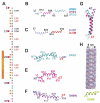Structural Plasticity of LL-37 Indicates Elaborate Functional Adaptation Mechanisms to Bacterial Target Structures
- PMID: 34068993
- PMCID: PMC8156758
- DOI: 10.3390/ijms22105200
Structural Plasticity of LL-37 Indicates Elaborate Functional Adaptation Mechanisms to Bacterial Target Structures
Abstract
The human cathelicidin LL-37 is a multifunctional peptide of the human innate immune system. Among the various functions of LL-37, its antimicrobial activity is important in controlling the microorganisms of the human body. The target molecules of LL-37 in bacteria include membrane lipids, lipopolysaccharides (LPS), lipoteichoic acid (LTA), proteins, DNA and RNA. In this mini-review, we summarize the entity of LL-37 structural data determined over the last 15 years and specifically discuss features implicated in the interactions with lipid-like molecules. For this purpose, we discuss partial and full-length structures of LL-37 determined in the presence of membrane-mimicking detergents. This constantly growing structural database is now composed of monomers, dimers, tetramers, and fiber-like structures. The diversity of these structures underlines an unexpected plasticity and highlights the conformational and oligomeric adaptability of LL-37 necessary to target different molecular scaffolds. The recent co-crystal structures of LL-37 in complex with detergents are particularly useful to understand how these molecules mimic lipids and LPS to induce oligomerization and fibrillation. Defined detergent binding sites provide deep insights into a new class of peptide scaffolds, widening our view on the fascinating world of the LL-37 structural factotum. Together, the new structures in their evolutionary context allow for the assignment of functionally conserved residues in oligomerization and target interactions. Conserved phenylalanine and arginine residues primarily mediate those interactions with lipids and LPS. The interactions with macromolecules such as proteins or DNA remain largely unexplored and open a field for future studies aimed at structures of LL-37 complexes. These complexes will then allow for the structure-based rational design of LL-37-derived peptides with improved antibiotic properties.
Keywords: LL-37; antimicrobial peptides; cathelicidin; structural flexibility.
Conflict of interest statement
The authors declare no conflict of interest.
Figures


Similar articles
-
Structural remodeling and oligomerization of human cathelicidin on membranes suggest fibril-like structures as active species.Sci Rep. 2017 Nov 13;7(1):15371. doi: 10.1038/s41598-017-14206-1. Sci Rep. 2017. PMID: 29133814 Free PMC article.
-
Structures of human host defense cathelicidin LL-37 and its smallest antimicrobial peptide KR-12 in lipid micelles.J Biol Chem. 2008 Nov 21;283(47):32637-43. doi: 10.1074/jbc.M805533200. Epub 2008 Sep 25. J Biol Chem. 2008. PMID: 18818205
-
High-quality 3D structures shine light on antibacterial, anti-biofilm and antiviral activities of human cathelicidin LL-37 and its fragments.Biochim Biophys Acta. 2014 Sep;1838(9):2160-72. doi: 10.1016/j.bbamem.2014.01.016. Epub 2014 Jan 23. Biochim Biophys Acta. 2014. PMID: 24463069 Free PMC article. Review.
-
Interaction of LL-37 human cathelicidin peptide with a model microbial-like lipid membrane.Bioelectrochemistry. 2021 Oct;141:107842. doi: 10.1016/j.bioelechem.2021.107842. Epub 2021 May 12. Bioelectrochemistry. 2021. PMID: 34049238
-
Tissue-specific Regulation of Innate Immune Responses by Human Cathelicidin LL-37.Curr Pharm Des. 2018;24(10):1079-1091. doi: 10.2174/1381612824666180327113418. Curr Pharm Des. 2018. PMID: 29589544 Review.
Cited by
-
Complexation of fungal extracellular nucleic acids by host LL-37 peptide shapes neutrophil response to Candida albicans biofilm.Front Immunol. 2024 Feb 6;15:1295168. doi: 10.3389/fimmu.2024.1295168. eCollection 2024. Front Immunol. 2024. PMID: 38384468 Free PMC article.
-
Protective Barriers Provided by the Epidermis.Int J Mol Sci. 2023 Feb 5;24(4):3145. doi: 10.3390/ijms24043145. Int J Mol Sci. 2023. PMID: 36834554 Free PMC article. Review.
-
LL-37, a Multi-Faceted Amphipathic Peptide Involved in NETosis.Cells. 2022 Aug 8;11(15):2463. doi: 10.3390/cells11152463. Cells. 2022. PMID: 35954305 Free PMC article.
-
Insight into the Mechanism of Interactions between the LL-37 Peptide and Model Membranes of Legionella gormanii Bacteria.Int J Mol Sci. 2023 Jul 27;24(15):12039. doi: 10.3390/ijms241512039. Int J Mol Sci. 2023. PMID: 37569419 Free PMC article.
-
Study on Optimizing Novel Antimicrobial Peptides with Bifunctional Activity to Prevent and Treat Peri-Implant Disease.Antibiotics (Basel). 2022 Oct 26;11(11):1482. doi: 10.3390/antibiotics11111482. Antibiotics (Basel). 2022. PMID: 36358137 Free PMC article.
References
-
- Koo H.B., Seo J. Antimicrobial peptides under clinical investigation. Pept. Sci. 2019;111:e24122. doi: 10.1002/pep2.24122. - DOI
Publication types
MeSH terms
Substances
LinkOut - more resources
Full Text Sources

